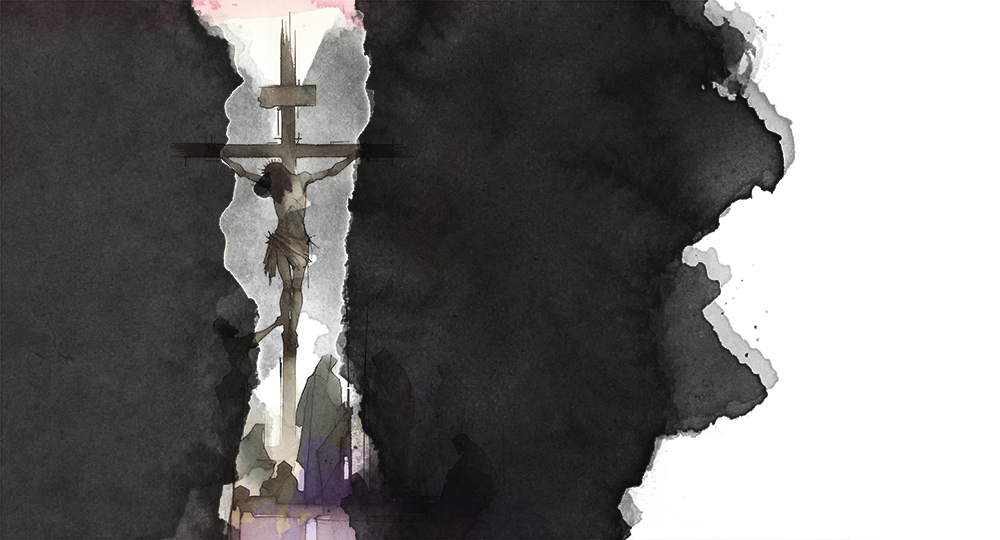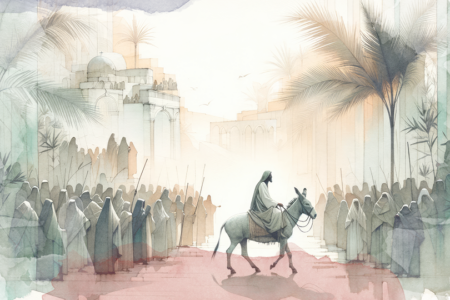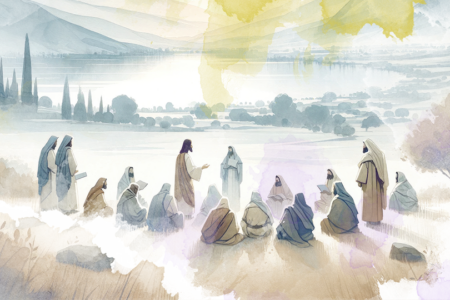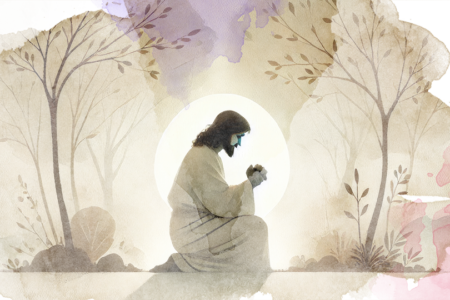To Calvary and Beyond
Jesus’ trials, crucifixion, death, burial, and resurrection
The resurrection of Jesus Christ is the foundation of the Christian faith. Jesus told His disciples He would be killed, as prophesied in Scripture (Isa. 53), but that He would be raised to life in three days: “Therefore, when He had risen from the dead, His disciples remembered that He had said this to them; and they believed the Scripture and the word which Jesus had said” (Jn. 2:22).
Jesus’ path to the cross was agonizing. It involved trials, scourging, pain, and suffering—all of which He sovereignly planned as “the Lamb slain from the foundation of the world” (Rev. 13:8). He willingly took on “the form of a bondservant, . . . coming in the likeness of men. And being found in appearance as a man, He humbled Himself and became obedient to the point of death, even the death of the cross” (Phil. 2:7–8).
The Trial
The crucifixion ordeal began when Jesus was arrested and taken before the notorious Sadducean priest Annas. Asked about His disciples and doctrine (Jn. 18:19), Jesus replied that He spoke openly and without ambiguity: “I always taught in synagogues and in the temple, where the Jews always meet, and in secret I have said nothing” (v. 20). A guard then struck Jesus in the face (v. 22).
Annas sent Jesus bound to his son-in-law Caiaphas, the Jewish high priest (v. 24). “Tell us,” Caiaphas demanded, “if You are the Christ, the Son of God!” (Mt. 26:63).
Jesus answered with a declaration, based on Psalm 80:17, that He was the Messiah and God: “It is as you said. Nevertheless, I say to you, hereafter you will see the Son of Man sitting at the right hand of the Power, and coming on the clouds of heaven” (v. 64; cf. Dan. 7:13, 22). In an unlawful and disgraceful display of judicial impropriety, Caiaphas tore his clothes while asserting, “He has spoken blasphemy! . . . He is deserving of death” (Mt. 26:65–66).
The religious leaders had a problem. They had to produce a way to convert their charge of blasphemy into a civil charge so that Rome could execute Jesus (Jn. 18:31). So, they leveled three accusations against Him before the Roman prefect, Pontius Pilate: “We found this fellow [1] perverting the nation, and [2] forbidding to pay taxes to Caesar, [3] saying that He Himself is Christ, a King” (Lk. 23:2).
Pilate, however, found no fault in Jesus (v. 4) and passed the responsibility to Herod Antipas, the murderer of John the Baptizer. Before Antipas, Jesus remained silent. “Then Herod, with his men of war, treated Him with contempt and mocked Him . . . and sent Him back to Pilate” (v. 11).
Before Pilate, Jesus acknowledged, “I am a king. For this cause I was born, and for this cause I have come into the world, that I should bear witness to the truth” (Jn. 18:37).
Pilate replied, “What is truth?” and again declared, “I find no fault in Him at all” (v. 38). Six times Pilate tried to free Jesus, but he succumbed to the pressure of those who wanted Christ killed. So, Jesus was sentenced to crucifixion.
Crucifixion and Death
Jesus was bound to a column and scourged savagely with a multilashed whip studded with bits of bone and metal that no doubt ripped His skin to shreds. The Roman soldiers twisted thorns into a crown, slapped it on His head, spat on Him, and struck Him on the head (Mt. 27:27–30).
He then was forced to carry a crossbeam through the narrow streets of Jerusalem to a place outside the city that we call Calvary. At the head of this grim procession, a soldier carried a wooden sign that read, “JESUS OF NAZARETH, THE KING OF THE JEWS” in Hebrew, Latin, and Greek (Jn. 19:19–20; cf. Lk. 23:38). At the execution site, Jesus was thrown to the ground atop the crossbeam. His arms were held out while iron nails pierced His wrists. Once secured, He was lifted up to an upright beam. One foot was placed over the other, and a nail was driven through them to the post. The wooden sign was nailed over His head for all to see.
The crucifixion occurred at 9 a.m. Friday morning. “With Him they also crucified two robbers, one on His right and the other on His left” (Mk. 15:27). It would have been obvious to those who knew Scripture that prophecy was being fulfilled:
But He was wounded for our transgressions, He was bruised for our iniquities; the chastisement for our peace was upon Him, and by His stripes we are healed. He poured out His soul unto death, and He was numbered with the transgressors, and He bore the sin of many, and made intercession for the transgressors (Isa. 53:5, 12).
From noon to 3 p.m., darkness covered the land (Lk. 23:44). The darkness suggested the presence of evil and the wrath of God being poured out on His Son for the sins of the world. Through His death, “Christ has redeemed us from the curse of the law, having become a curse for us (for it is written, ‘Cursed is everyone who hangs on a tree’)” (Gal. 3:13). “For He made Him who knew no sin to be sin for us, that we might become the righteousness of God in Him” (2 Cor. 5:21).
On the cross, Jesus would have heard the blowing of the shofar to begin the sacrifices of the Passover lambs. People would have started singing the Hallel Psalms 113—118, a collection of thanksgiving prayers sung on festive holidays that begins with “Hallelujah,” meaning, “Praise the LORD.”
As the last lamb was slaughtered, the shofar would sound one final time. It is probable that at the very moment the people sang Psalm 118:25—“Save now, I pray, O LORD; O LORD, I pray, send now prosperity [deliverance]”—Jesus said, “It is finished!” meaning, “paid in full!” (Jn. 19:30). Jesus paid the redemption price for our sin with His shed blood (Rom. 6:23). Christ then dismissed His spirit (Mt. 27:50; cf. Jn. 10:17–18).
Burial and Resurrection
Joseph of Arimathea, a secret follower of Jesus, boldly asked Pilate for Christ’s body. He then laid it in a new tomb. Together with Nicodemus, who brought scented ointment, they anointed and wrapped Jesus’ body in strips of linen.
Calling Jesus a “deceiver” (Mt. 27:63), the priests and Pharisees told Pilate they remembered Him saying that after three days, He would rise from the dead. So, they requested that Pilate station armed guards at the tomb to prevent the disciples from stealing Jesus’ body. Roman guards and an official seal were posted.
Would Psalm 16:10 now be fulfilled? “For You will not leave my soul in Sheol [the realm of the dead], nor will You allow Your Holy One to see corruption [to rot in the grave].” It would indeed!
On the first day of the week, two women went to the tomb:
And behold, there was a great earthquake; for an angel of the Lord descended from heaven, and came and rolled back the stone from the door, and sat on it. And the guards shook for fear of him, and became like dead men. But the angel answered and said to the women, “Do not be afraid, for I know that you seek Jesus who was crucified. He is not here; for He is risen, as He said” (Mt. 28:2, 4–6).
The angel told them to tell Jesus’ disciples that He is risen. “He is going before you into Galilee; there you will see Him” (v. 7). As the women left, Jesus met them and said to them, “Do not be afraid. Go and tell My brethren to go to Galilee, and there they will see Me” (v. 10). And, of course, they did.
The ancient Jews believed in the resurrection. Each day they recited a prayer called the Amidah, composed of 18 blessings. The second states belief in resurrection:
Thou, Lord, art mighty to all eternity, Thou raisest the dead, Thou art mighty to save. In kindness He satisfieth the living, in great pity He raiseth the dead; He upholdeth those that fall; He healeth the sick and setteth free them that are bound; He will manifest His faithfulness to those who sleep in the dust. Who is like the Lord of might, and who is like Thee, Thou King, Who killest and makest alive, and causest salvation to spring forth? Faithful art Thou to restore life to the dead; blessed be the Lord Who restoreth life to the dead.”1
The Sadducean priests, who didn’t believe in the resurrection, obviously would not have recited the resurrection prayer. However, the Pharisees, who rejected Jesus’ Messiahship but believed in the resurrection, would have. Yet, in seeking to cover up what they knew to be true, both committed a serious sin stemming from a hatred of Jesus without cause (Jn. 15:25) and hearts hardened by an antiresurrection bias.
Jesus Christ’s resurrection is the foundation of the Christian faith. The resurrection declares that you can whip Jesus, nail Him to a cross, wrap Him in linen cloths, and seal Him in a tomb. But you still cannot destroy Him because He is God. And this is our assurance: “He who raised up the Lord Jesus will also raise us up with Jesus” (2 Cor. 4:14).
Jesus is the eternal God of Israel. That is why He could say, “No one takes [My life] from Me, but I lay it down of Myself. I have power to lay it down, and I have power to take it again” (Jn. 10:18). And because He lives, we, too, shall live if we place our faith in Him.
ENDNOTE
-
-
- Alfred Edersheim, The History of the Jewish Nation, 3rd ed., revised by Henry A. White (Grand Rapids, MI: Baker Book House, 1979), 340.
-
Photo: Adobe Stock








